THE ICON WAS EXECUTED SILICATE PAINTS; A PAINT INVENTED IN THE 19TH CENTURY IN GERMANY TO IMITATE THE PHYSICAL AND VISUAL PROPERTIES OF THE TRADITIONAL FRESCO ON A VARIETY OF SUBSTRATES. THESE PAINTS CAN WITHSTAND THE VOLATILE CLIMATES
OF NORTH AMERICA AND EUROPE. SILICATE PAINTS HAVE BEEN
SUCCESSFULLY USED FOR WALL PANTING IN BYZANTINE CHURCHES. THIS IS THE FIRST RECORDED USE OF THIS MEDIUM IN A COPTIC CHURCH.
Abba Anthony
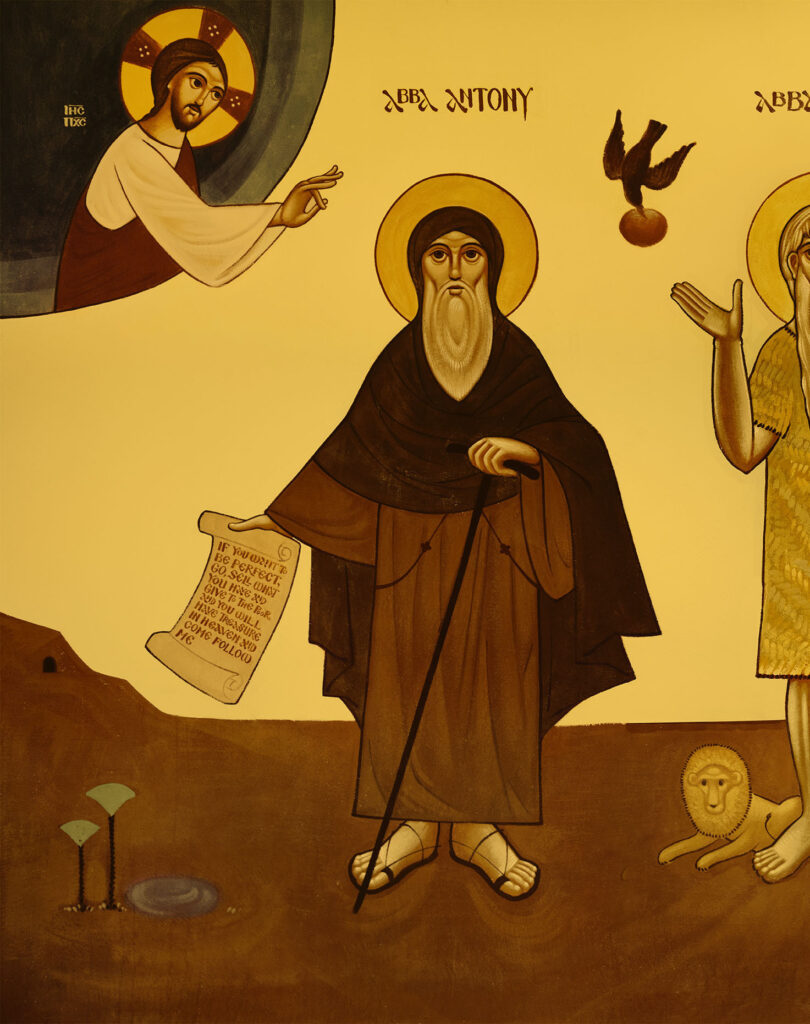
Saint Anthony was the first Christian to live a life of consecrated solitude. He is considered the father of the monastic family. He was born to rich parents in the middle of Egypt. When he was eighteen, his parents died, leaving him guardian of his younger sister. Six months later Anthony entered the church to hear the Gospel where it says, “If you would be perfect, go sell all you have, give to the poor and come follow me”. He took this advice as a personal invitation addressed to him by God. He gave his wealth to the poor and needy, and he took his sister and placed her with some virgins. At that time, monasticism had not yet been established. All those who wanted to live a solitary life went and lived on the outskirts of the city. This was what St. Anthony did as he dwelt alone, worshipping, and living an ascetic life. He was about thirty-five years old when he left his retreat to move to the east bank of the Nile. After twenty years, his reputation attracted many followers who settled near him, and wished to copy his holy life. Saint Anthony became their spiritual leader, teaching them the ascetic life. Five years later, he again retired into solitude in the “Inner Mountain”. As Saint Anthony lived in solitude, he was tempted by boredom and discouragement and he started praying asking the lord to guide him. After a little while, he began to walk in the open and saw someone as if it was himself, sitting and working – making mats of palm leaves – and then rising to pray, which was repeated several times until Anthony understood that he had to combine manual work and prayer in the monastic life. He told his disciples that just as Christ was a carpenter and Paul was a tent maker, they also had to keep their hands busy to escape temptations. The angel also revealed to him the uniform of the monks. Saint Anthony died at the age of one hundred and five, but his influence extended beyond his lifetime.
St Paul of Thebes
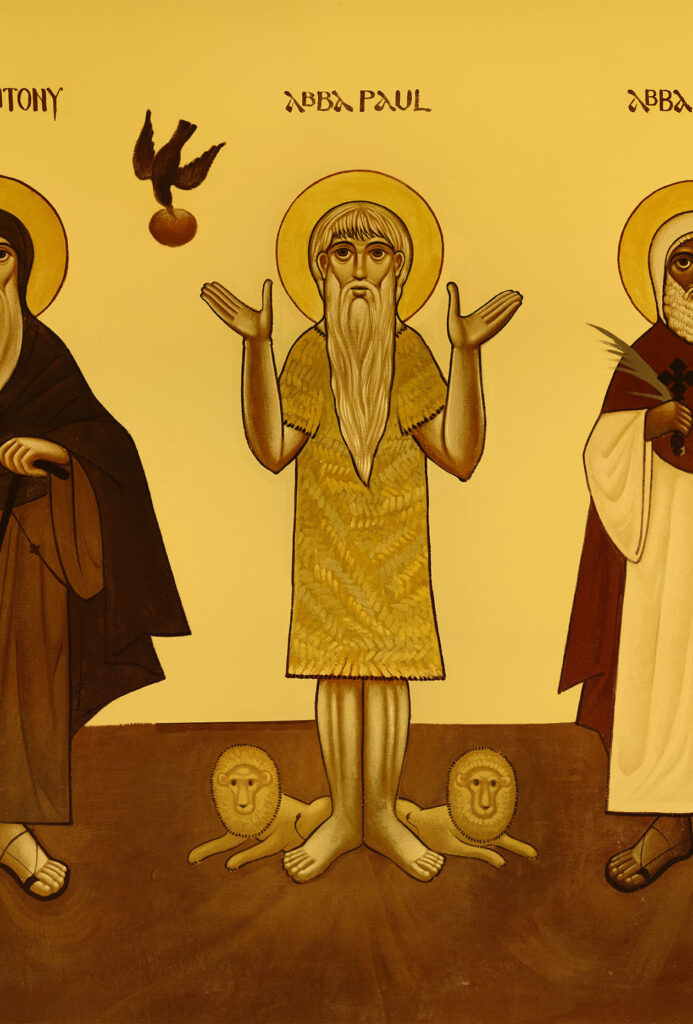
Paul was born in Egypt, where he was orphaned by age 15. He was also a learned and devout young man. During the persecution of Decius in Egypt in the year 250, Paul was forced to hide in the home of a friend. Fearing a brother-in-law would betray him, he fled in a cave in the desert. His plan was to return once the persecution ended, but the sweetness of solitude and heavenly contemplation convinced him to stay.
He went on to live in that cave for the next 90 years A palm tree and a spring near his cave provided him food, clothing, and water until he turned 43. After that time, as it had happened for Elias, a raven brought him half a loaf of bread each day. Without knowing what was happening in the world, Paul prayed that the world would become a better place.
Saint Anthony later visited Saint Paul to accompany him. On that day, the raven arrived with a full loaf of bread instead of the usual half. They both knew it was time for the departure of Saint Paul and his final request was to be wrapped in the cloak that was given to St Anthony from St Athanasius. St Anthony went to get the cloak and came back to find out that St Paul has departed. Two lions dug Paul’s grave and Anthony buried him. Thought to have been about 112 when he died, Paul is known as the “First Hermit.”
St. Macarius the Great
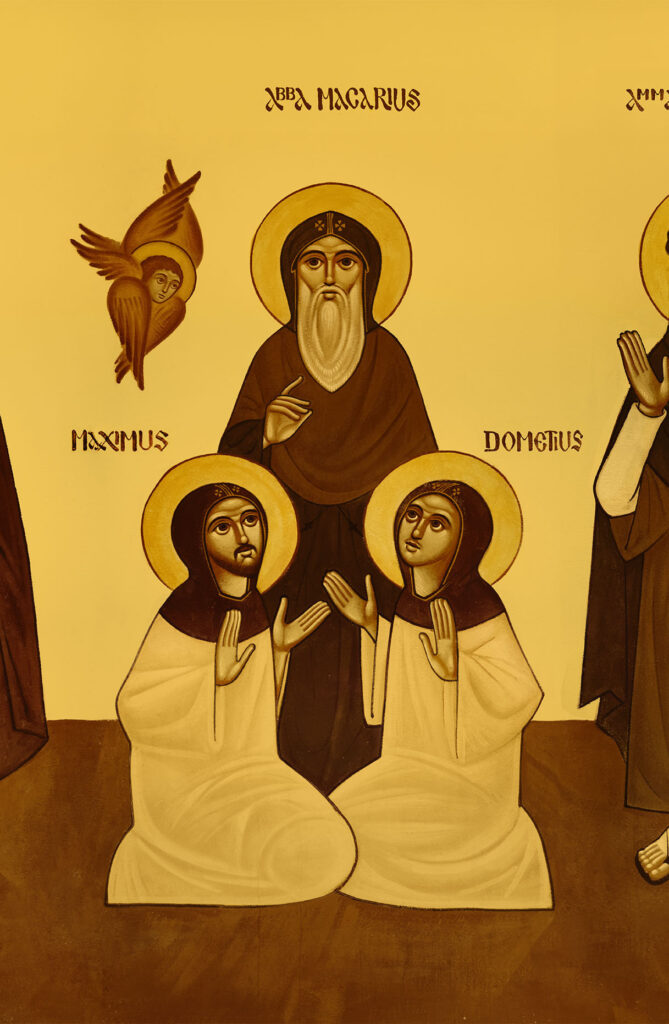
Saint Macarius the Great was from the Thebaid of Egypt, a disciple, of Saint Anthony the Great. He was born about 331 and struggled with asceticism in the desert at Scete. Although young, he was called “the child elder” because of his great wisdom and austere manner of life. He was ordained a presbyter and reposed in 391, at the age of sixty. There are fifty homilies ascribed to him. It is said of Saint Macarius that he became a God upon earth, for even as God protects the whole world, so did he cover the faults he saw as if he did not see them. Once he came back to his cell to find a thief taking his things and loading them on a camel. Macarius’ non-possessiveness was so great that he helped the thief load the camel. When the camel refused to rise, Macarius returned to his cell and brought a small hoe, said that the camel wanted the hoe also, loaded it on, and kicked the camel telling it to get up. The camel obeyed Macarius’ command, but soon lay down again, and would not move until everything had been returned to Macarius. His contemporary, Saint Macarius of Alexandria, was so-called because he came from Alexandria and was therefore of that Greek-speaking colony; while Saint Macarius the Great is also called “of Egypt,” that is, he belonged to the ancient race native to Egypt, the Copts.
Saint Moses the Black
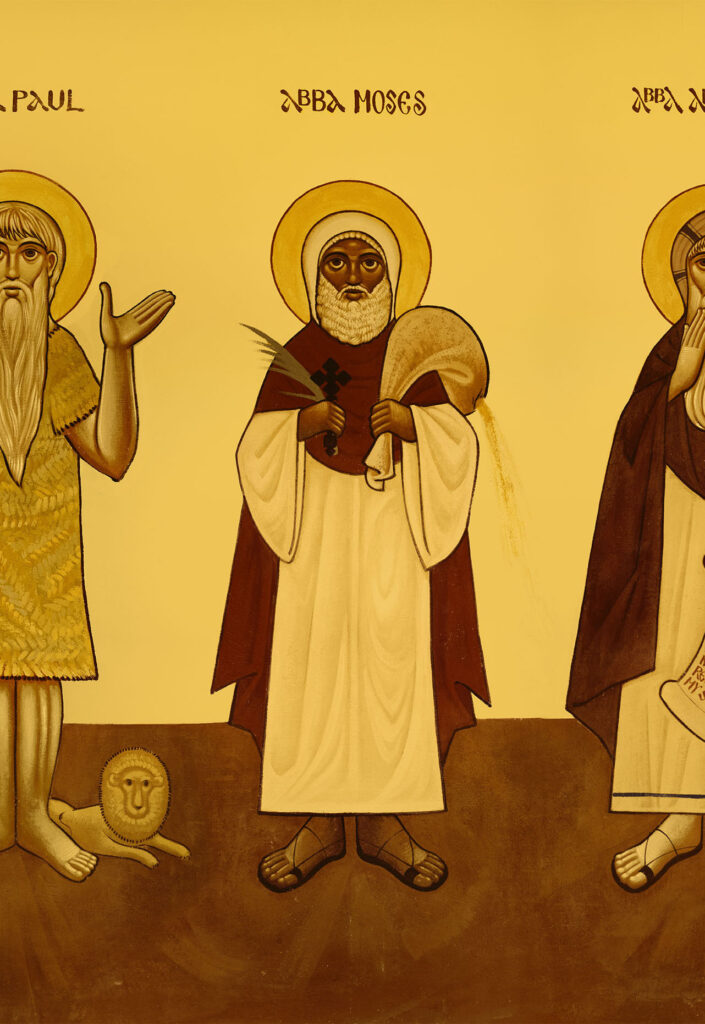
Saint Moses the Black lived during the fourth century in Egypt. He was an Ethiopian and in his youth he was the slave of an important man, but after he committed a murder, his master banished him, and he joined a band of robbers. They chose him as their leader because of his bad character and great physical strength. Moses and his band of brigands did many evil deeds, murders, and robberies. It was mentioned that St. Moses used to address the sun saying, If you are god let me know, and You the God whom I know not, lead me to You. St. Moses heard from someone that the monks in the wilderness of Scetis knew God, so he immediately girded himself with his sword and went to the wilderness. Moses spent several years leading a sinful life, but through God’s great mercy, he repented, left his band of robbers, and went to one of the desert
monasteries. Here he wept for a long time, begging to be admitted as one of the brethren. After many years of monastic exploits, St Moses was ordained deacon. St Moses labored for fifteen years in this rank and gathered around himself 75 disciples. When the saint reached age 75, he warned his monks that soon brigands would descend upon the Skete and murder all that were there. The saint blessed his monks to leave, in order to avoid violent death. The robbers killed St Moses and the six monks who remained with him. Their death occurred in about the year 400.
St Arsenious
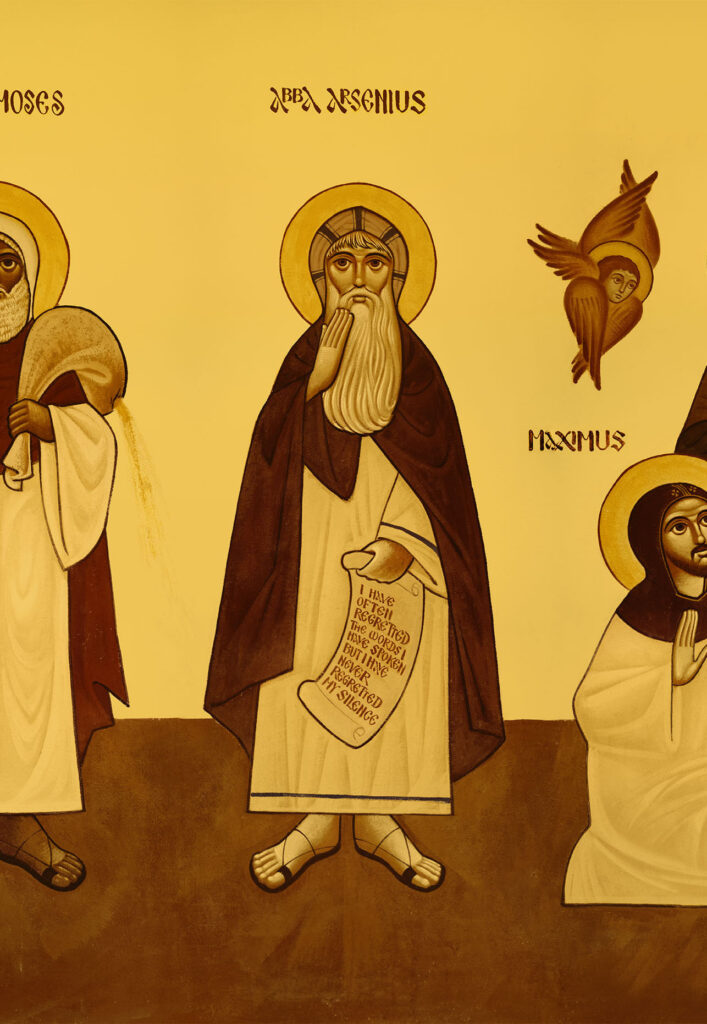
St arsenious was born in Rome and at the age of forty he fled to Egypt to live a monastic life in the wilderness of Sheheat. So, one day the devils came to him in the shape of angels, blessing him for his holiness and determination (in order to make him commit the sin of pride). But he cried for God and just then all the devils evaporated in the air.
While he was praying and meditating, the devils were very angry because of that, and they wanted to enter his room, but they because he was praying, so they started to make a bad noise outside to disturb him, but he scolded them. After that, the devils ran away with disgrace.
When he knew that his departure was soon to come, he went out to visit his disciples as
usual, he told them his departure is soon. And him and his disciples in tears. Then he crossed over his body, and peace returned to his face, and died.
After that a great light column appeared over the place, and his face shone. Everybody then knew about his death, and many people came (monks and laymen) to take the blessing from his body, and a lot of sick people recovered.
Maximus and Domatius

Walendianus was one of the Roman emperors who feared God and was Orthodox in faith. God gave him these two sons, Maximus and Domatius, who were angelic in their purity and holiness
since their young age always praying and reading the holy books. When they realized the vanity of this world and all its glory, they decided to leave it and live a monastic life. They asked their father to allow them to go to the City of Nicea, to pray. Their father rejoiced, and he sent an entourage of soldiers and servants with them, as was the custom for the children of kings. When they arrived, they asked the soldiers to go back to their father and tell him that they wanted to stay there for some time. Then they revealed their thoughts to a saintly monk, that they desired to put on the holy garb of the monks. The monk did not agree with them because he feared their father, but he
advised them to go to Syria where St. Agabius abided. They went to St. Agabius and stayed with him until his departure. God granted them the gift of healing the sick. Their report was heard in all the countries, especially among the sea merchants and travelers. They learned the trade of making ships’ sails, and they were able to support themselves with money earned from selling them, and they gave the rest to the poor and the needy. After a while, the Patriarch of Rome departed, and they remembered Maximus, whom they wanted to ordain in his place. His father rejoiced when he heard this. When the news arrived to St. Maximus and his brother, they remembered the command of their father Anba Agabius. They told St. Macarius that they wanted to live under his guidance.
Then St. Maximus became sick. He sent word to St. Macarius, asking him to come. When St. Macarius arrived, he found St. Maximus ill with a fever, and he comforted him. St. Macarius saw a company of prophets and saints, including St. John the Baptist and Emperor Constantine, gathered around the Saint until he delivered his pure spirit in dignity and in honor. St. Domatius, his brother, wept bitterly and asked St. Macarius to pray on his behalf to the Lord Christ to take him also to be with his brother. After three days, he also became sick, and when St. Macarius knew by the spirit he went to visit him. On his way, he saw the company of saints who carried St. Maximus before carrying the soul of St. Domatius ascending to heaven. When he arrived at the cave, St. Macarius found that St. Domatius had passed away.
Saint Amma Syncletica of Alexandria
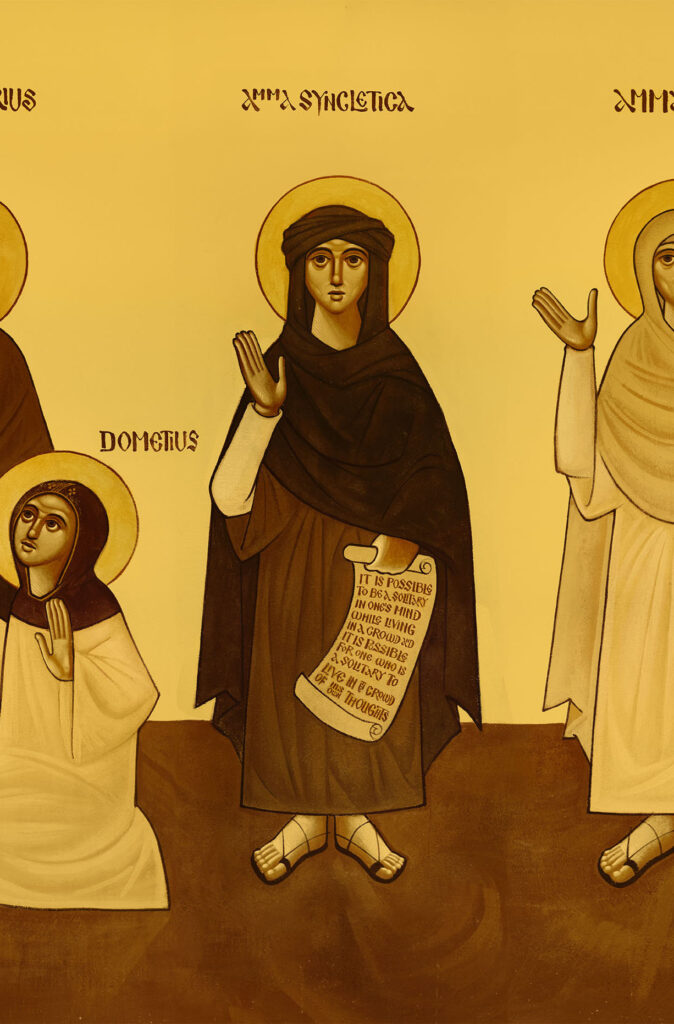
Saint Syncletica was a native of Alexandria of Macedonian heritage, the daughter of wealthy parents. She was very beautiful, well educated, and was a woman of high social status, but from a young age she focused only on the things which were pleasing to God. Loving the purity of virginity and the ascetic life, she refused to marry anyone, proceeded to cut her hair as a sign of her consecration to God, and spent all her time in fasting and prayer. After the death of her parents, Syncletica distributed all her inheritance and possessions to the poor and withdrew to the wilderness with her younger sister who was blind. At the time, Saint Syncletica was one of the few women that faithfully followed the example of Saint Anthony the Great in fasting, praying and inspiring others to join them in asceticism. News of her ascetic deeds and spiritual gifts of discernment and healing quickly spread throughout the region, and many devout women and girls came to her seeking the life of monasticism. Amma Syncletica reluctantly agreed to serve as their spiritual mentor, and she was considered the “mother of Christian nuns”. During her ascetic life, the Saint zealously instructed the sisters by word and by deed.
In her eightieth year, Saint Syncletica suffered from an intense and grievous illness. She bore this illness with Christian endurance while suffering from intense physical pain for 3 years. The day of her death was then revealed to her in a vision, so she gathered the nuns and gave them her final instructions before departing in peace.
Saint Zosima
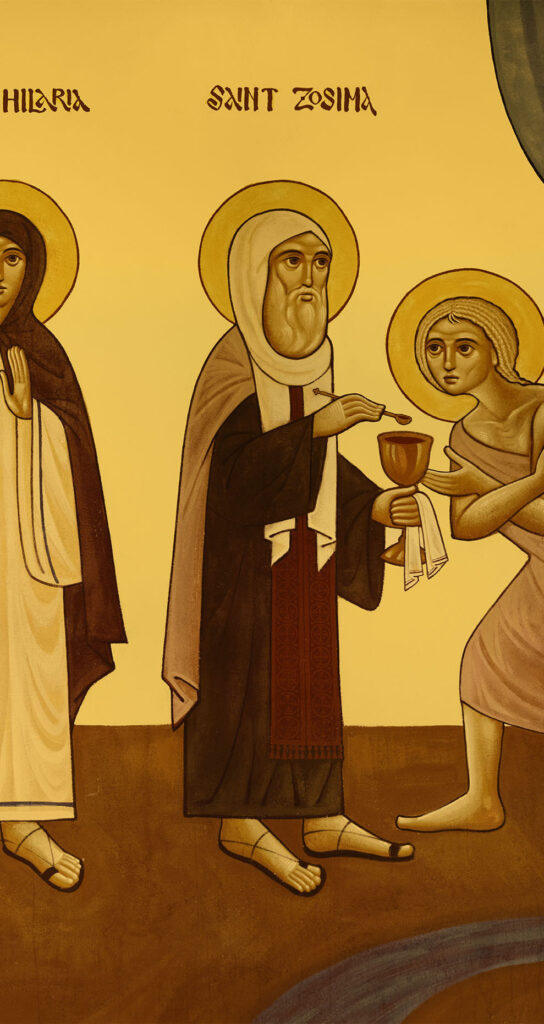
Saint Zosima was born from Christian Palestinian parents. When he was 5 years old, they handed him to a righteous old monk, who raised him in a Christian manner and taught him the doctrine of the church, and shortly after they ordained him a deacon. He became a righteous monk and grew in virtues, continually praising God and reading the scriptures. When Saint Zosima had completed 35 years in the monastery, they ordained him a priest and he continued to increase his ascetic labors and struggle. After spending 13 years in this struggle, the enemy sowed in his mind the evil thought that he was superior to all his contemporaries in virtues and righteousness, but the Lord willed to turn him away from this thought and sent an angel to him and commanded him to go to the monastery which was near the river Jordan. Saint Zosima obeyed and went to the monastery where he found righteous old men who were more perfect in their contending than him so he decided to remain with them in the monastery.
During the Holy Lent, it was the custom of the monks to disperse in the desert of Jordan, each fighting their own spiritual battles. Each year Saint Zosima would follow this custom asking the Lord to show him who was more perfect than him. One year while he was walking in the desert, he met Saint Mary of Egypt. He learned about her story and the reason she decided to live in the wilderness. She asked him to return the following year with the Holy Eucharist. St. Zosima indeed returned the next year with the Holy Eucharist. In the following year, he revisited her as requested but she had already departed so he buried her body and returned to the monastery and told the monks the story of the strife of this holy woman, and they all increased in steadfastness and progressed in their spiritual lives.
St. Sarah the Nun
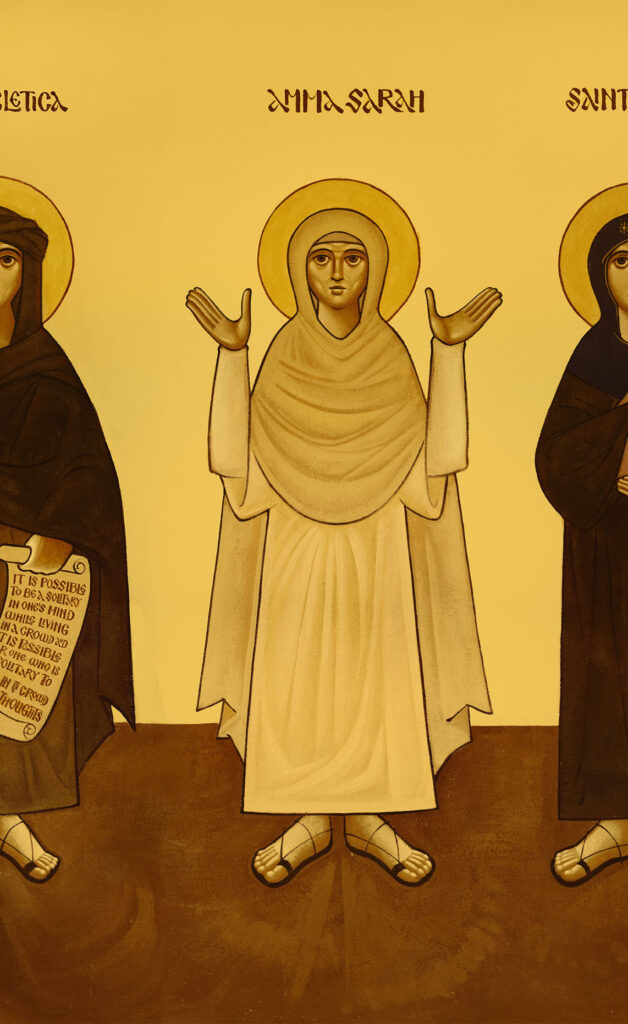
Sarah was a single child to extremely rich parents who were natives of Upper Egypt. Her parents were devout Christians who raised her in a Christian manner and taught her how to read and write. From her readings, she was influenced by the lives of the monks and desired the ascetic monastic life, so she went to the convents of Upper Egypt and dwelt there for many years. After serving the virgins in the convents for many years, she put on the monastic garb and began her 13 year persistent fight against Satan, until he had become weary of her. When Satan was exasperated by her steadfastness and purity, he desired to make her fall for the sin of pride. He appeared to her while she was standing praying on the roof of her cell and said to her: “Rejoice for you have overcome Satan.” She replied: “I am a feeble woman, and I can not conquer you except by the power of the Lord Christ” and then Satan vanished. Amma Sarah stayed in solitude on the banks of the river in a cave for sixty years fighting a great fight until she departed in peace at eighty years old. Amma Sarah has many wise saying that she often said to the nuns and are written in the Paradise of the Fathers.
St. Marina the Ascetic
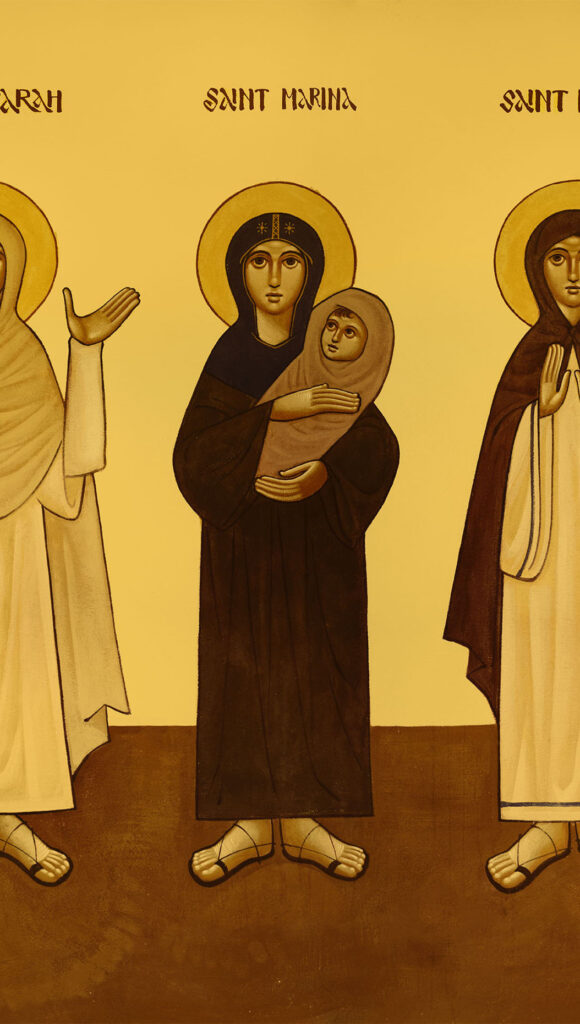
Saint Marina the Ascetic’s birth name was Mariam, and she was the daughter of a very rich Christian man. When Mariam was a little girl, her mother passed away and her father continued to raise her in a true Christian upbringing. When Mariam was older, her father wanted to give her in marriage as he desired to pursue the monastic life. Mariam insisted on accompanying him and immediately shaved off the hair on her head and put on the garb of a man. From this day forwards, her father called her Marina instead of Mariam. Marina and her father then went to one of the monasteries and lived together in one of the cells for 10 years fighting the spiritual fight before her father passed away. One day, the abbot of the monastery decided to send her along with three other monks for a certain business in the city. During her stay, Marina was accused of defiling the virginity of the daughter of the inn keeper. Once the daughter conceived, she told her father that it was the young monk, abba Marina. The furious father went to the monastery and spoke to the abbot who rebuked Marina greatly and immediately cast her out of the monastery and she dwelt outside the monastery for a long time.
When the daughter of the inn keeper delivered her baby, her father took the baby to St. Marina who nursed and took care of the child as though he was her own. After three years outside the monastery, the abbot agreed to readmit her, but he laid heavy penalties and severe rules upon the Saint. Saint Marina continued to raise the child and when the child grew, he also became a monk. After St. Marina had completed forty years, she fell ill for three days and then departed in peace. The Abbot ordered to replace her old, ragged clothes with new ones prior to carrying her to the place of praying. When they removed her clothing, they were surprised to see that she was a woman. Once the Abbot and the inn keeper were informed, they wept profusely because of what they had done to her. After she was buried, God allowed a devil to torment the inn keeper’s daughter as well as the soldier and brought them to where the Saint was buried, and they both confessed their iniquity in front of everyone.
Saint Hilaria, Daughter of Emperor Zeno
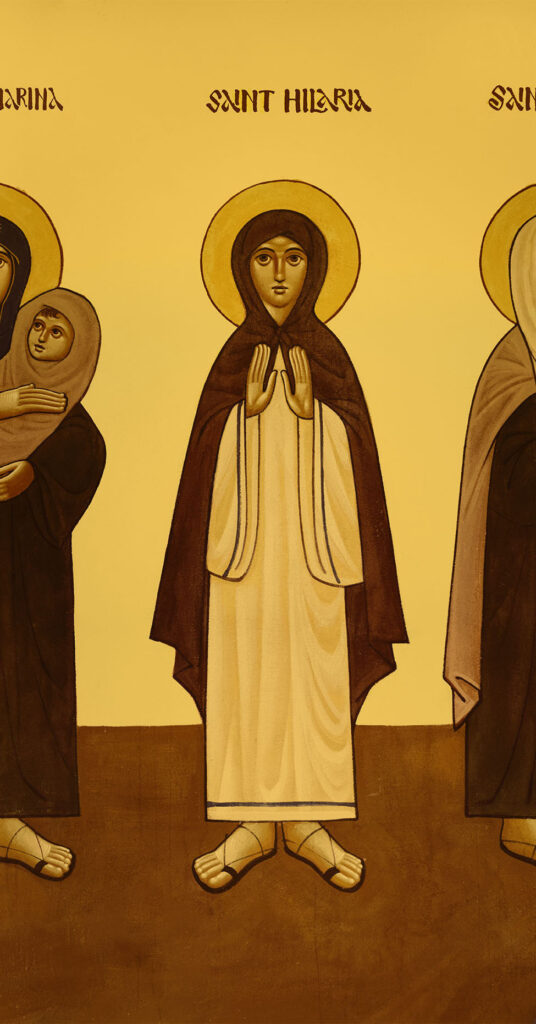
St. Hilaria was the daughter of Emperor Zeno, an Orthodox believer, who loved the church and raised Hilaria and her sister, Thaopesta in the strong Christian faith. Since a young age, Hilaria contemplated pursuing the monastic life. When she was 18 years old, she left her family and travelled to Egypt, disguised in men’s clothing. In the wilderness of St. Macarius, Hilaria met a holy man, Anba Pemwah who ordained her a monk under the name of Hilary. Three years later, Anba Pemwah found out the truth but decided to keep her secret and left her in a cave where she stayed for 15 years. When she did not grow a beard, the monks thought that she was a eunuch, and they called her “Hilary, the eunuch”.
Meanwhile, her sister Thaopesta became possessed with an unclean spirit, and her father spent on her a great deal of money in vain. The men of his court advised the emperor to send her to the elders of Sheheat, since the fame of their holiness had spread to all the Roman districts. The emperor sent Thaopesta to the elders asking them to pray for her so that the Lord may heal her. The monks prayed for many days, but she was not healed so the fathers decided to take her to St. Hilary. St. Hilaria refused as she knew that the princess was her sister, but the elders insisted. A few days later, Thaopesta was healed from her illness, and she returned to her father’s empire and explained to them all that had happened. The emperor then requested the elders to send St. Hilary so that he may receive his blessings. The Saint pleaded not to go but when the elders insisted, St. Hilary obeyed and went to the emperor. Hilaria then made herself known to her parents who wept profusely. After remaining for 3 months, she retuned to the wilderness. The emperor then built many cells for the monks as well as a beautiful palace in the monastery of St. Macarius. From that time onwards, the number of monks increased in the wilderness. After returning, St. Hilaria remained in the wilderness for 5 years before departing in peace. Until the time of her departure no one knew that St Hilary was in fact a woman.
Saint Mary of Egypt
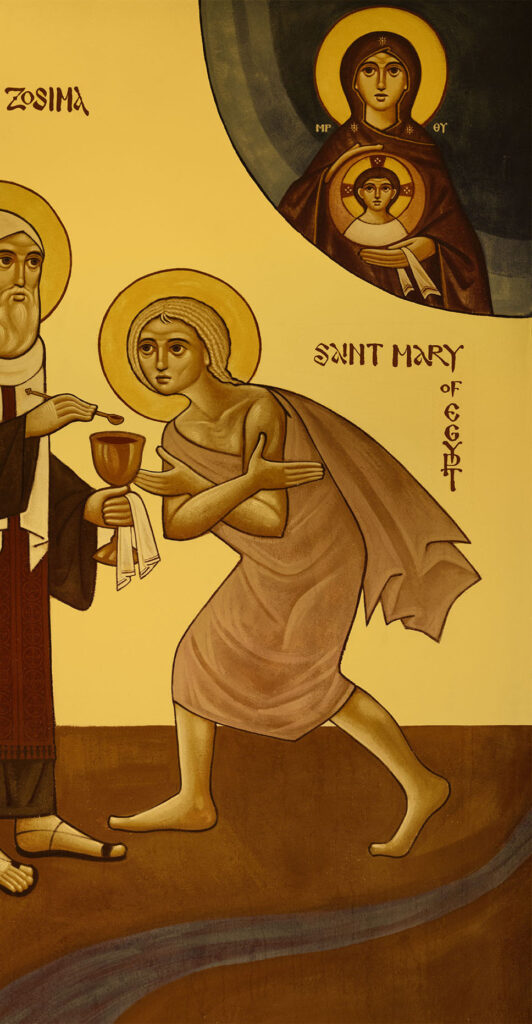
Saint Mary of Egypt was born in the city of Alexandria from Christian parents. When she was 12 years old, Satan led her astray, and made her his net through which he caught innumerable souls. She continued in this sinful conduct for 17 years until the mercy of God touched her life. One day, she met people who were going to Jerusalem, but she did not have enough money to pay for the trip, so she decided to live a sinful life and gave herself to the owners of the ship in return. In Jerusalem, she decided that she wanted to go to the church of the Resurrection but as she tried to enter through the door, she felt a hidden power pulling her from the back, preventing her from entering the church. Realizing that this was because of her uncleanliness, she wept, and asked St. Mary to intercede on her behalf. After praying, she was able to enter the church where she stood before the icon of St. Mary and asked her fervently to guide her. She immediately heard a voice coming out of the icon saying: “If you cross the Jordan river, you will find rest and salvation” so she immediately rose and crossed the Jordan river to the wilderness where she lived for 47 years.
During her 45th year in the desert, St. Zosima went to the wilderness during the Holy Lent, according to the custom of the monks there. While he was walking in the desert, he met Saint Mary of Egypt. After the greetings, she asked him to pray for her because he was a priest. She also asked him to return the following year with the Holy Eucharist. St. Zosima indeed returned the next year with the Holy Eucharist. In the following year, he revisited her as requested but she had already departed and he saw a lion standing beside her body and writing that said ” Bury Mary, the poor woman, in the dust of which she was created.” The lion beside the body dug a grave for her and St. Zosima prayed over her body and buried her. When he returned to his monastery, he told the monks the story of the strife of this holy woman, and they all increased in steadfastness and progressed in their spiritual lives.

